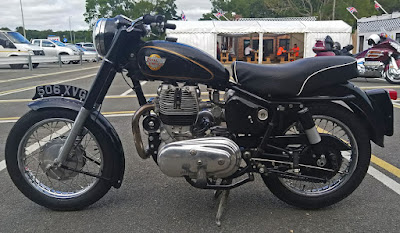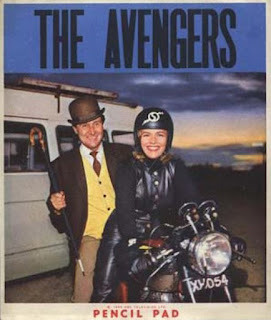 |
| Honor Blackman poses on a Royal Enfield in the role of Cathy Gale. |
Photos of leather-clad actress Honor Blackman posing on a Royal Enfield motorcycle turn up on Royal Enfield forums from time to time.
The photo of the future "Bond girl" (Pussy Galore in "Goldfinger") could have been a publicity shot for a 1964 episode of the television series "The Avengers."
In one version of the photo Avengers star Patrick Mcnee, bowler hat in hand, joins his female co-star on the Royal Enfield.
"The Avengers" was a popular UK show of the 1960s, with McNee as the dapper and witty secret agent John Steed and Blackman as agent "Catherine Gale." The series eventually came to U.S. television screens, with the sleek Diana Rigg replacing Blackman in the skin-tight costumes, as agent "Emma Peel."
Distracting females playing spies with suggestive names are one thing, but it was the Royal Enfield motorcycle that caught the attention of the Royal Enfield Interceptor forum recently.
What model was that shiny Royal Enfield twin in the picture? The answer could be: one you've never heard of.
It may be a model rare enough that Mark Mumford, a member of the Interceptor forum, recently went to considerable trouble to recreate one, out of simple "curiosity." More on that below.
Whatever it is, the Blackman Royal Enfield is extensively modified with a clever rear-set gearshift and twin "clocks" added to the handlebars above the trademark Royal Enfield casquette.
With so much shine and pizzazz, the motorcycle has been identified as a Constellation, Royal Enfield's big roarer of the era, with chrome everywhere, a 700cc twin-cylinder motor and 19-inch wheels.
But it's not that.
 |
| Note that their feet are flat on the ground. She was five-foot six, he was five-11. |
One clue, oddly, is that Blackman and Mcnee pose with their feet comfortably flat on the ground. Their motorcycle is in fact a 500cc Royal Enfield Meteor Minor, with smaller frame and wheels than the Constellation.
Julian Green noted the differences, and wrote in to The Gun magazine for April/May 2019 to describe them.
"The giveaways are the Meteor Minor-sized 17-inch wheels with Meteor Minor-spec forks, and a Meteor Minor-spec fuel tank. Also the barrels are too short for a Constellation, though you need to look closely to see this," he wrote. "The non-standard rev-counter (Ed: one of those "clocks") has the take-off from a Constellation-spec timing cover."
The Royal Enfield Meteor Minor lasted only from 1958 to 1963. The "Minor" name distinguished it from the big brother Meteor of 1953, a 700cc motorcycle that eventually became the aptly named Royal Enfield Super Meteor.
Royal Enfield repackaged the modest sounding Minor as the Meteor Minor Sports and, in its final year, dropped "Minor" entirely, renaming the model the 500 Sports Twin.
All this is clear from Roy Bacon's book "Royal Enfield The Postwar Models."
But then it gets confusing.
The Blackman Royal Enfield might be something much less well known, Graham Scarth, chairman of the Royal Enfield Owners Club UK advised forum members.
It might be "an early Meteor Minor Sports with 17-inch wheels and a frame that is smaller than the 700s (but not as small as the Crusader 250 type). Ideally suited to those of a smaller stature."
Meteor Minors eventually used frames akin to the big Meteors. Earlier Minors had their own, distinct small frame.
"I believe 'The Avengers' photo shows a small frame Meteor Minor but could only be 100 per cent sure if we knew the frame number and we don’t, of course," Graham wrote me, in an email.
How rare are the small frame Meteor Minors? Graham has studied the factory records.
"First block of frame numbers for Meteor Minors covered 250 machines dispatched between February ’58 and April ’59. All of them would be small frame type. None of them went to Canada, and the U.S. was getting the (500cc twin) Tomahawk at this time, which never had the small frame. Do not know if any more had small frame as not enough photos of them," Graham told the forum.
 |
| Meteor Minor frames as seen in Hitchcocks Motorcycles parts books. Unique 1958 frame is at left. 1960 frame at right, with same part number shown as for 700cc Meteor. Key difference is bottom of the front downtube. Note front of headstock of the latter fame has attachment points for the Airflow fairing that appeared for 1959 season. The small frame didn't last long enough to get these. |
Size isn't the only difference in the "small frame" Meteor Minor. Graham attached a photo to illustrate.
"Note the cast block at bottom of front downtube with two holes for front engine plates, which is unique to this smaller frame used for the Meteor Minor only," he wrote. "Later Meteor Minors have the bigger 'large lug' frame with T-shaped socket casting on the front down tube."
A real surprise came at about this point in the conversation.
"I recently finished the rebuild of a 'small frame' Meteor Minor," member Mark Mumford advised the forum.
 |
| Mark Mumford's recreated small frame Meteor Minor. Although "only" 500cc, the motor looks huge in this frame. |
 |
| Mark had the frame in hand but much else had to be sourced, based in part on educated guesses about what items are common to other models. |
"It uses most of the cycle parts of the 250 Crusader with some special bits to make it fit the frame, which is sized between the 250 and 700 type frames...
"My guess is that the small frame only lasted about six months before someone on the production side pointed out the extra costs and complexity, the engine is such a tight fit it would be slow to build on the production line.
"Along with the extra different parts not common to anything else the profit margin must have been nil. It took me a long time to find all the correct parts, the rear brake pedal being just such an item, eventually found NOS on eBay," he wrote.
"I acquired the bare frame only in a job lot of parts some 20 years ago and my curiosity eventually took me to this," he wrote me, in an email.
Mark was inspired in his work by a photo in Bacon's book, captioned "1957 Meteor Minor 500 with siamesed exhaust pipes."
"I've done the bike as per the factory photo in Roy Bacon's book," Mark wrote, allowing for some changes that were personal preference, such as a more svelte front fender.
I asked Royal Enfield Owners Club archivist Bob Murdoch if the club files have that 1957 photo and what, if anything, is written on it. He did not find it in the archives.
I asked Mark what his recreated small frame Meteor Minor is like to ride. His response:
"Performance wise I'd rate it as like a super Crusader, very revvy."
His motor is the Sports version introduced late in the Meteor Minor's run. Bacon credits it with "special cams, valves and springs to raise the power a little." In his Appendix he lists the Sports with 33 bhp at 6,500 rpm compared to 30 bhp at 6,250 rpm for the usual Meteor Minor.
"It accelerates really well and as a short stroke motor it can be safely revved quite hard without complaint, which is an unusual feeling for someone used to the longer stroke of the (700cc) Meteors/Super Meteors/Constellations and even longer stroke Interceptors! I think top speed when I find out what it is, is going to be hobbled by what feels like very low gearing," Mark wrote me.
"When I assembled the bike I was already aware that a friend (John Dove) had experienced this on his own later (large frame) machine and indeed, I thought so myself when I rode it. His solution was to rebuild the wheels with 18-inch rims, which gave more ground clearance (the footrests are very low in corners with the extra width of the twin engine over a Bullet or Crusader) and this had the useful bonus of raising the overall gearing without compromising the handling.
"On which point, the small frame definitely turns in much faster, like a lithe polo pony over a racehorse? Or is that too pretentious! Thinking about it now, it would be a superb urban bike, slim enough with the narrow bars to filter through traffic (legal here) and fast enough to get away from the lights. Enough legs for that stretch of faster suburban dual carriageway and with excellent brakes to avoid the undecided shopping driver.
"Maybe what Enfield had in mind all along, a quality commuter for the older man who wasn't a dedicated motorcyclist in that era before small cheap cars?"
In his book, Bacon attributes the demise of the Royal Enfield 500cc twins to "a motorcycle world split by the needs of learner 250s and high performance. There was no longer any place for a 500 twin so, in 1963, the final example of the small Enfield twin went from the range."
Mark is a "Machine Specialist" in the Royal Enfield Owners Club UK, answering questions about the Royal Enfield 700cc Super Meteor and Constellation. To avail yourself of his advice, join the club. It's one of the benefits members enjoy.
In particular, if you'd like to emulate his decision to bring a small frame Meteor Minor back to life, he has made a list referring to the 1958 Parts Book illustrations and numbers of the unique parts needed to construct the "small frame" bike. You're going to need that.
Finally, a bit more on "The Avengers" episode with the Honor Blackman and the Royal Enfield. In "Build a Better Mousetrap," her character Cathy Gale rides not the Royal Enfield shown in the still photos, but a mild looking Triumph Speed Twin with large fairing. Cathy joins a motorcycle gang to investigate a "spell" supposedly cast on its motorcycles by elderly sisters who object to their noise.





























The lovely Emma Peele moniker was a take off on the tabloids "Man Appeal" catchphrase, i.e. M.Appeal,becomes Emm Appeal then "Emma Peele". The skin tight leathers certainly didn't hurt the image any either! ;-)
ReplyDeleteHonor Blackman was a Wren in WWII -- a motorcycle dispatch rider for the Royal Navy. That was one reason this episode was produced as it gave Honor a chance to show off her riding skills as Cathy. It's a fun episode.
ReplyDelete